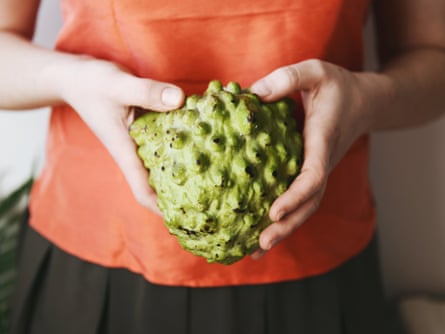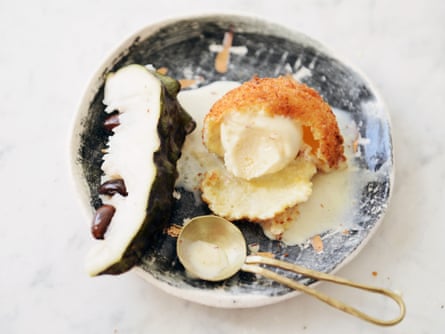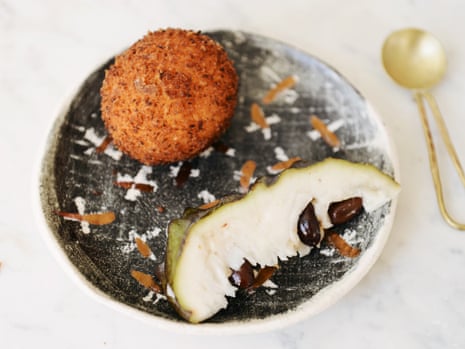I was in northern New South Wales recently. At the organic farmers’ market, stalls were selling custard apples by size. $1 for the smallest ones, $3 for the medium, and $5 for ones that needed two hands to hold. Away from the coast, the nights can still get cold, but the days were warm, T-shirt weather. It was glorious in the sunshine and I bought custard apples, eating one right then and there. These custard apples were straight from local growers, but fruit is available in southern states at this time of year.
The fruit is heart-shaped and a green that blackens as it ripens. Custard apples are some times referred to as sweetsop, or ox-heart, and there are many varieties, some of them small and reticulated as they ripen. In Australia, the Pinks Mammoth and African Pride are the most commonly commercially produced fruit. The varieties look quite similar and both are sweet and juicy. The Mammoth, living up to its name, is the larger of the fruit, reaching up to 3kg in weight. The African Pride usually weighs in below 1kg.
People can be funny about custard apples, perhaps not knowing quite what to expect. They’re absolutely nothing like an apple, and though they do taste creamy and sweet, they don’t exactly taste like custard. Leave them too long before eating and they can taste fermented; cut too early, they’re hard and inedible. But it’s easy to tell when they’re ripe. The Australian varieties are at their best when green and when they give a little when pressed. If their skin has changed to a purple-black, they’re past their prime. Ripe, they should smell sweet and fragrant. Avoid buying small, underdeveloped, dark green fruit.

Custard apples can be bought unripe, much like an avocado and allowed to ripen at home. They’re a tropical fruit, and will ripen slowly in a cold climate, so keep in a warm spot and hasten the process as you would an avocado, by paper bagging the custard apples with a ripe banana. Do not eat the nubbly green skin – simply quarter the fruit and scoop out the creamy fresh. The flesh will be pitted with shiny, black pips. There is nothing quite as succulent as the velvet, sweet flesh of the custard apple, scooped out with a spoon.
Here, instead of fussing with the custard apple itself, we have a recipe for deep-fried ice cream that makes a delicious accompaniment. In the depths of winter, hot ice cream is a delightful sensation. It’s also easier to make at this time of year – you don’t have to work as quickly as you must in summer.
After frying, the ice cream will be frozen at its middle, and gooey towards the outside. We’ve used a coconut crumb rather than a batter and store-bought ice cream, though homemade coconut ice cream would be very good. A tropical dessert – even for those of us living with these frosty mornings.

Custard apples with deep-fried coconut ice cream
2 ripe custard apples, quartered
1 litre coconut ice cream/vanilla ice cream (homemade or quality store-bought)
1 ½ cup desiccated coconut
1 ½ cup breadcrumbs
3 free-range eggs, beaten
A dash of milk
Vegetable oil, for deep frying
Put a tray into the freezer.
To make breadcrumbs, put a quarter of a stale loaf of good-quality white bread in the food processor – and process until the bread is crumbed. You can do this in advance, whenever you have leftover old bread.
When the tray is icy cold, remove from the freezer and cover with baking paper. Scoop ice cream into firm balls and put them on the cold tray. Freeze the ice cream balls for at least two hours before handling them again. In the meantime, mix the desiccated coconut and bread crumbs in a bowl. Mix the eggs, and a dash of milk in a separate bowl.
When the ice cream balls are frozen solid, remove from the freezer, and working quickly, roll the balls in the coconut mix. Dip the coconut coated balls into the egg mix, then back into the coconut mix and repeat. The ice cream will be protected by two layers. A good trick is to use one hand only for the wet ingredients, and one hand only for the dry ingredients, so you don’t end up with coconut ball fingers. Refreeze.
Heat the oil until hot (190C) and then fry each ball individually for 20 to 30 seconds. They should be a rich golden brown. Remove to a paper towel, then serve immediately with the fresh cut custard apple quarters.
Makes about 12 balls.

Comments (…)
Sign in or create your Guardian account to join the discussion